People
An Exclusive Tour With Architect Peter Marino of His Exhibition at the Tiffany Landmark
The star curated a group show that included Richard Prince, Jean-Michel Basquiat, and Sarah Sze. It was a personal endeavor.
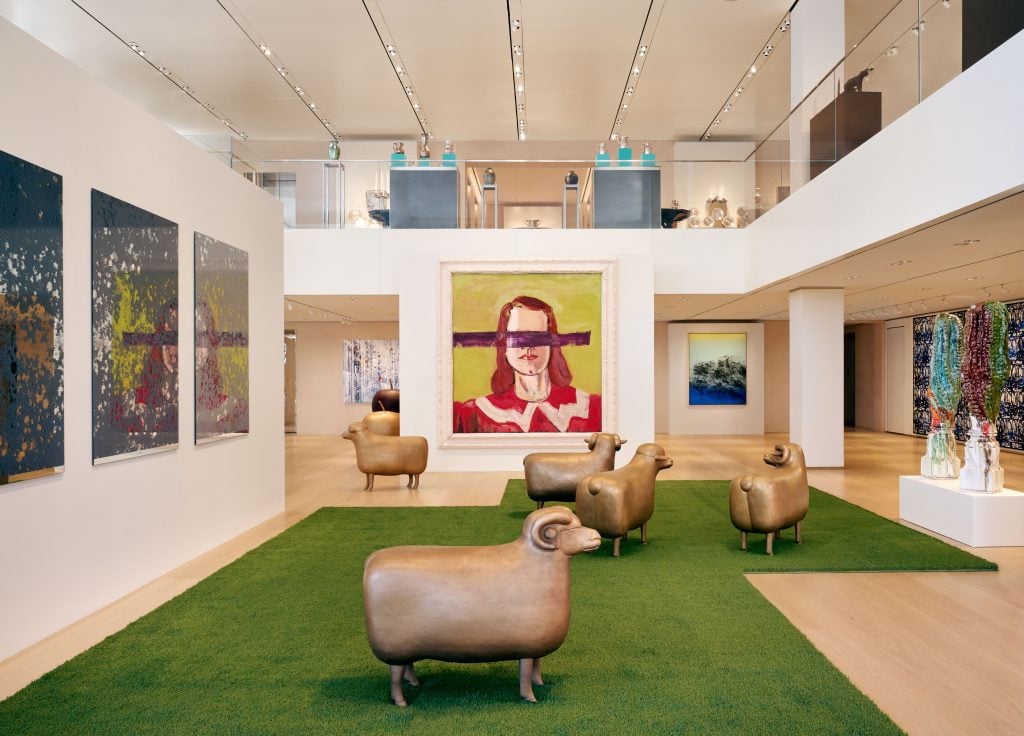
It’s already a surreal experience to visit The Landmark. Tiffany & Co.’s 10-story Manhattan luxury retail temple focuses just as much on displaying its massive art collection as it does jewelry. The Tiffany Blue-adjacent Basquiat that hangs by the ground floor elevator is now as synonymous with the brand as Audrey Hepburn’s portrayal of Holly Golightly. But this was Valentine’s Day, and also Ash Wednesday, so the aisles were bustling with romantics, many with ominous daubs of soot on their foreheads. Oh, and the Landmark’s architect, interior designer, and art curator Peter Marino was in his customary full black leather regalia astride a bronze ram. It was a very mythological scene, the dark prince upon his mighty steed.
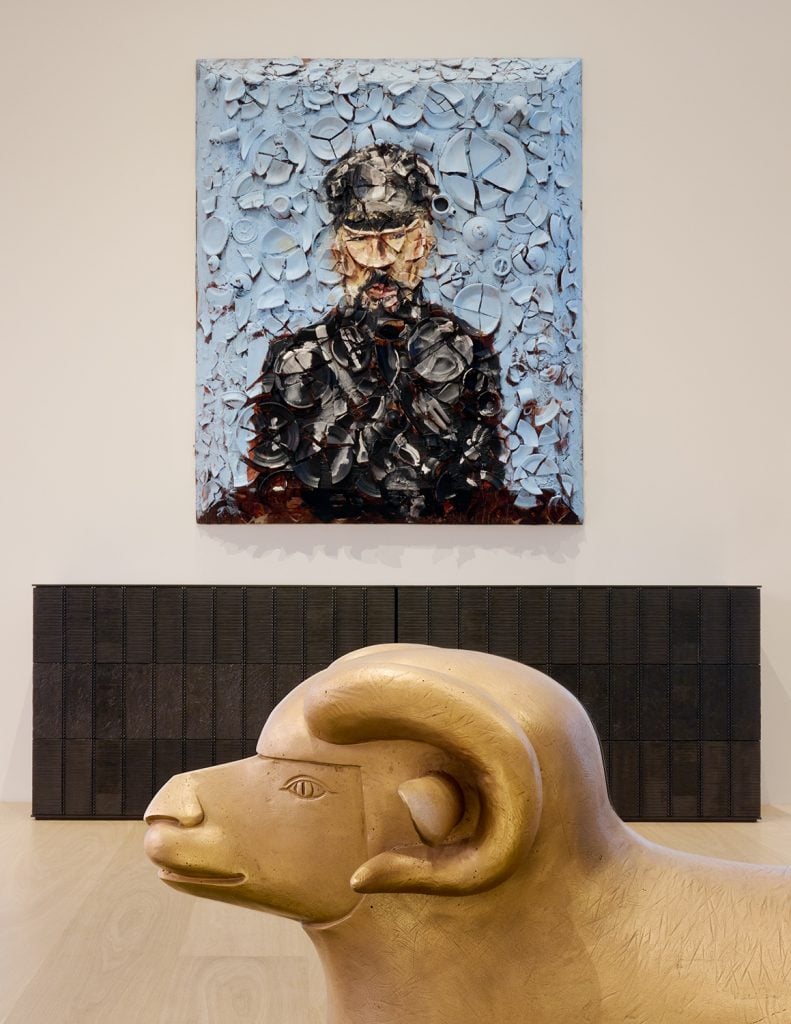
In this installation shot, Julian Schnabel’s mixed media portrait of Peter Marino hangs over one of the architect’s bronze “boxes. A Les Lalanne sheep is in the foreground. Photo: Jason Schmidt. Courtesy Tiffany & Co.
Marino was sitting on one member of his eponymous Les Lalanne flock, “Les Grands Moutons de Peter.” Five are now grazing upon artificial grass at “Culture of Creativity,” the Landmark’s inaugural art exhibition taking place in a two-story gallery space on the ninth floor. “It’s meant to look like it’s thrown together,” Marino said, taking a break from installing the show, “but it isn’t.”
“Culture of Creativity” has been part of the Tiffany VIP experience since late February. This week it opened to the public (free with reservation) and runs through May 20. Basically, it’s a group show from the artists featured throughout the building—including Rashid Johnson, Sarah Sze, and Richard Prince—sourced from the architect’s Southampton Peter Marino Art Foundation. There are also works by Marino, and quite a few of Marino. With this show, Marino is not only telling the Landmark’s narrative, but really, his own as well.
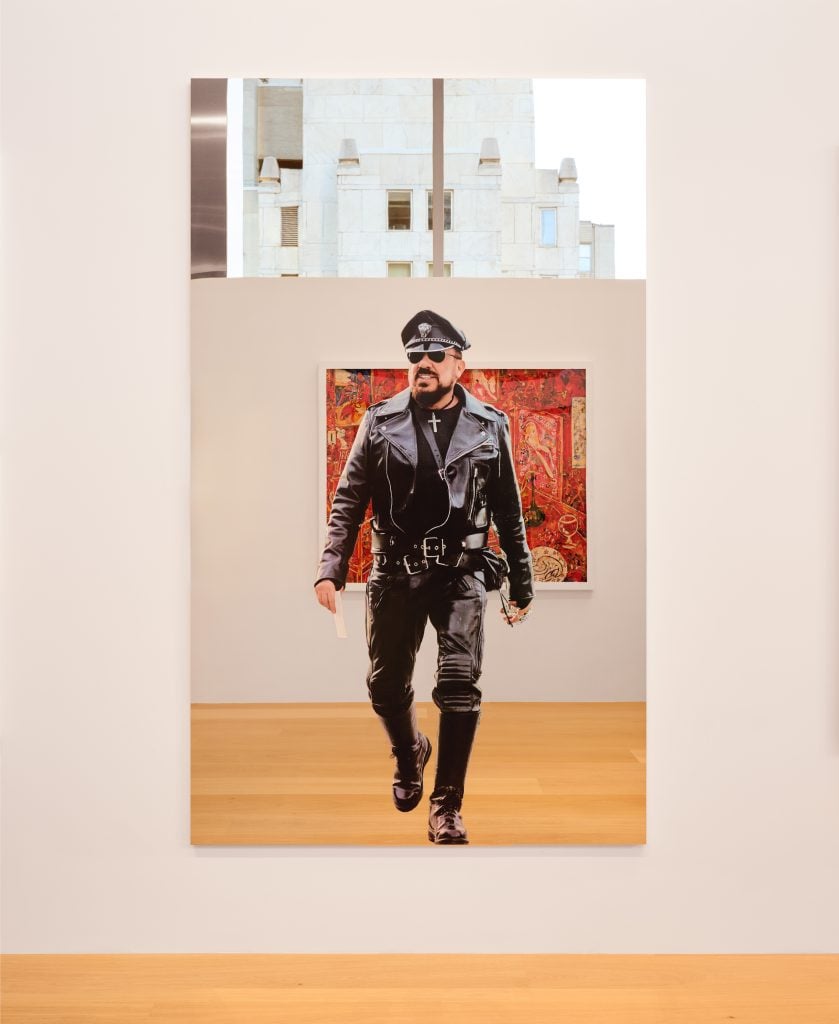
An installation view of “Culture of Creativity.” Photo: Jason Schmidt, Courtesy Tiffany & Co.
“It may be too personal,” he said. “I may be revealing too much about myself.” Marino has a connection to all of the artists, all of them are his friends. He motioned at Sze’s gleaming silkscreened mirrors. “I got these 20 years ago, before she was such a hot tamale. I know the artists and I collect all their work and have been collecting since forever. It’s been my life.”
The husband-and-wife duo Francois-Xavier and Claude Lalanne summered at Marino’s Southampton house for 12 years. He has about 30 of their sculptures in his 12-acre garden there. He curated their 2010 retrospective at the Louvre’s Musée des Arts Decoratifs that repositioned them as Surrealist mainstays. “Part of my mission was to say that there is no such thing as decorative art,” Marino said. “I loathe that term. And well, all art is decorative. But according to certain curators and certain very highfalutin museums, Rothko is not decorative. And I go, ‘No that’s just out and out depressing and I agree with you.’”
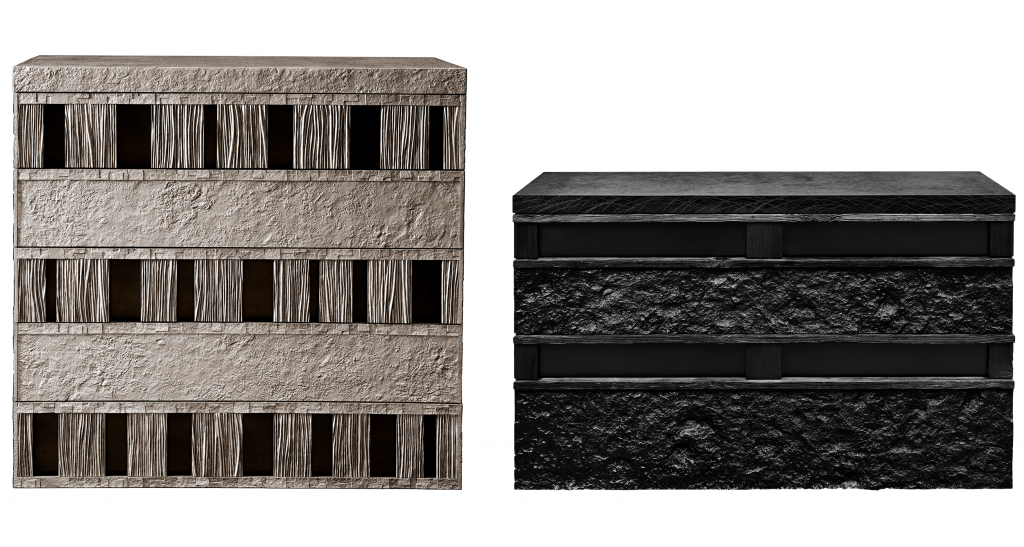
Peter Merino, Silver Novella Box (2014) and Rough Stone Box (2017). Courtesy of Peter Marino Architect
Don’t dare call Marino’s own otherworldly bronze “boxes” decorative, either, although they are functional (they have an ingenious hidden panel that smoothly releases a drawer once pushed). He shows them with Gagosian and creates them for clients. Intricately textured, they look biomechanical and both ancient and futuristic, monolithic and funereal. They weigh between 250 and 1,000 pounds and, although casket-like, in a sense they are a way for him to be immortal. The ones spread throughout the Landmark aren’t for sale.
“There was a mini eureka moment when I went to see an incredible show of bronzes at the National Gallery in London,” he said of their germination. One work in particular, depicting a Greek God and dating to 400 B.C., had been discovered at the bottom of the sea and was in near-perfect condition. “That lasted 3000 years! I did the Armani building on Madison Avenue. [Real estate developer] SL Green bought it and knocked it down already. Thirty years later they just knocked it down!”
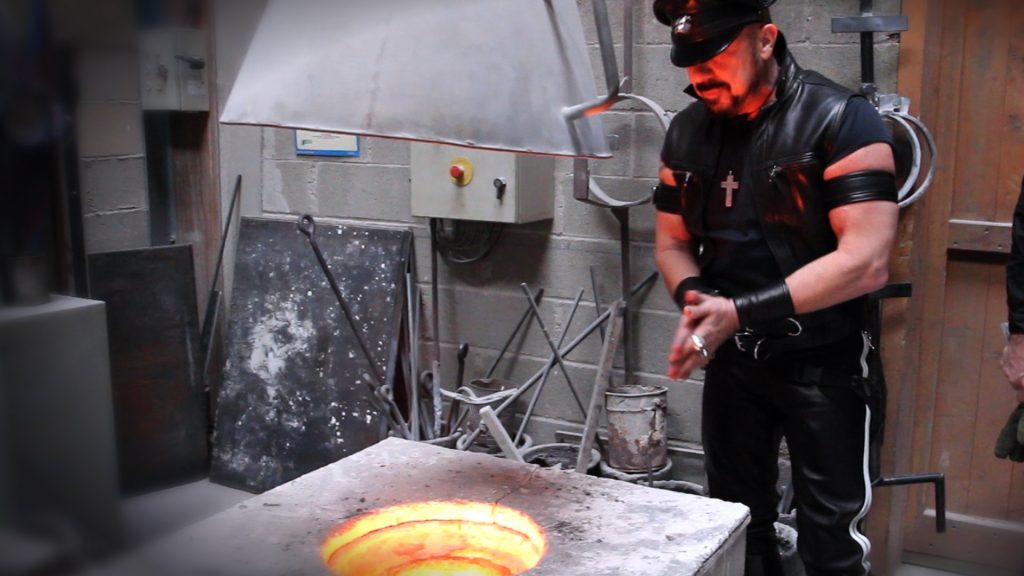
Marino at work on his bronze “boxes” at a forge in France. Courtesy of Peter Marino Architect
The realization that even his architectural work would not be permanent pushed him into sculpture. “I want something that lasts. Bronzes can withstand an atomic attack,” he said. Marino shopped around several bronze foundries before he discovered the penultimate in the south of France. “It took a while to get into,” he recalled “They’re very grand and they made the gates for Versailles. You can’t get your foot in the door, particularly for a slimy American. But I was hanging out and hanging out. I was seriously interested in bronze art.” Marino returns there about once a month for weekends of firing and casting new boxes.
Marino is also a passionate and tireless gardener, beekeeper, jewelry designer, philanthropist, textile artist, author, glassblower, and model and muse. He posed for Julian Schnabel’s mixed-media portrait, which is on view in the exhibition, for eight hours. “I think he got me,” Marino said of his pensively ruminative countenance rendered in painted shattered dishware. Elsewhere there are three sumptuously moody Roe Ethridge portraits of the architect. In one photograph he’s leaning on Erwin Wurm’s Peter Marino in 100 Years, which is a skeleton in a motorcycle jacket and cap. In another he’s standing next to the Swiss artist Not Vital’s abstracted sculptural rendition of him, Peter Marino.
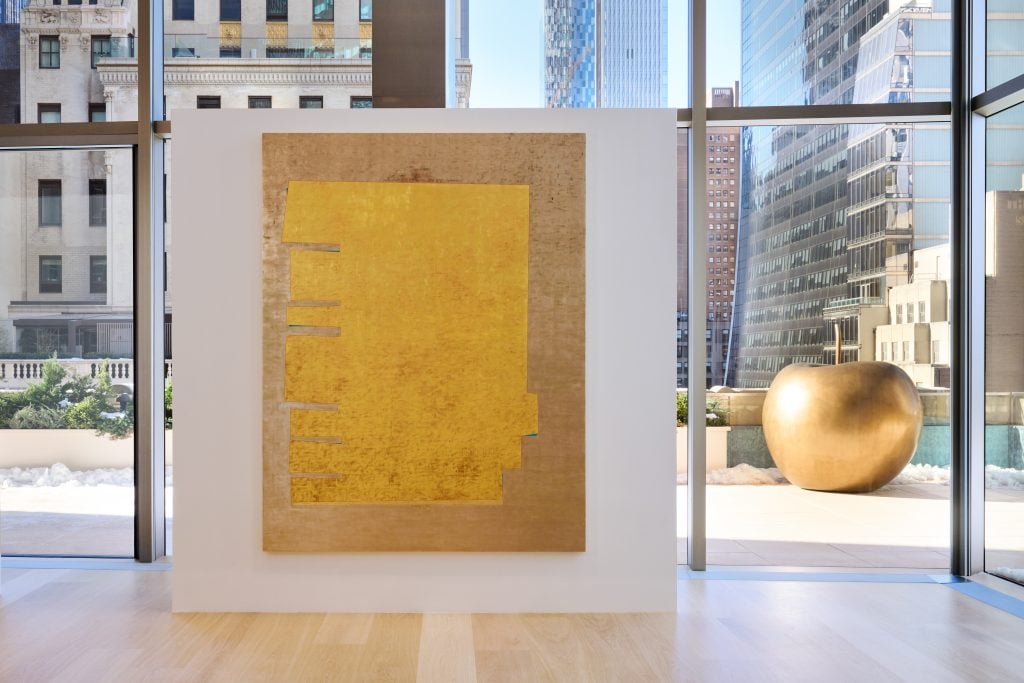
A golden Les Lalanne apple on the terrace accentuates Jenny Holzer’s Copy. Photo: Jason Schmidt, Courtesy Tiffany & Co.
“Andy [Warhol] said to pretty much all of the boys, ‘you should have yourselves photographed a lot. You’ll be amazed at how handsome you were five years from now.’” Marino recalled. “It’s so true. Did you ever see a photo of yourself five years ago? You go, ‘you know, it wasn’t so bad.’ That was Andy’s whole thing.” Marino designed the artist’s Upper East Side townhouse in 1978 as well as the third Factory. “Warhol launched my career,” he said.
We stroll past Vik Muniz’s take on Warhol’s Rorschach test paintings. What does Marino see in it? “I see eagles in absolutely everything,” he said. “I’m an eagle freak. I can’t show you my back, but trust me,” he added, alluding to a tattoo. On one hand is a silver ring (of his own creation) that covers three fingers of fierce eagle heads with sharp raptor beaks. “Biker stuff,” he explained, “to scare the shit out of people down highway. I made it about five years ago. I used to have singles on three different fingers and they kept knocking, so I said ‘Just glue ’em together.’”
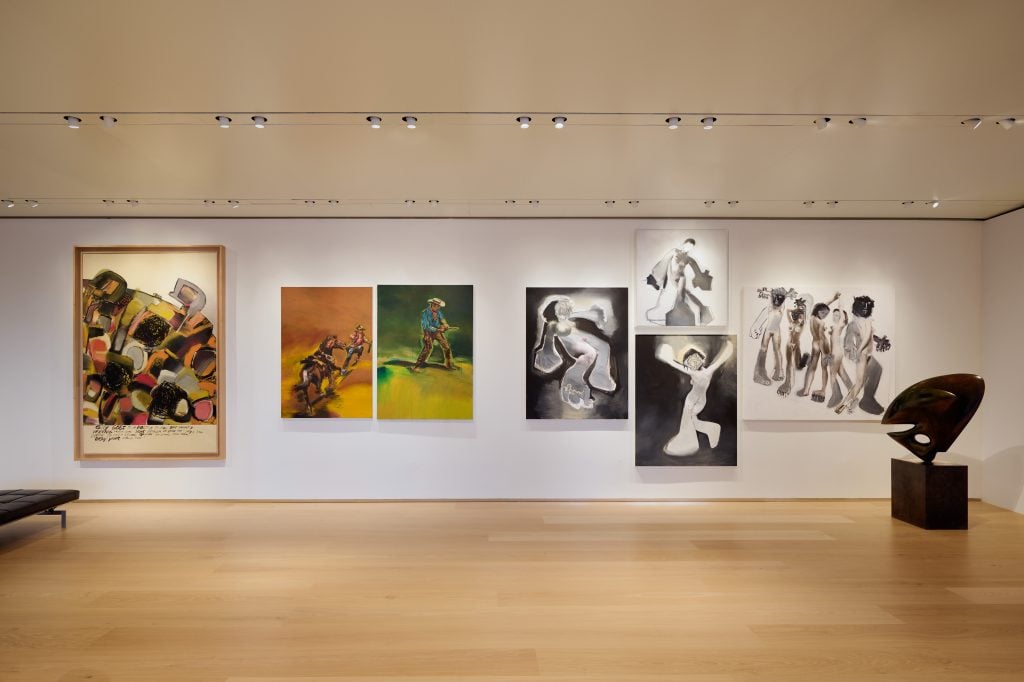
An installation view of Peter Marino’s exhibition. Photo: Jason Schmidt, Courtesy Tiffany & Co.
A gleaming gold Les Lalanne apple outside on the terrace accentuates Jenny Holzer’s grand auric delight Copy. Holzer also created a limestone table for Marino. “I’m 45 years of New York City art history,” Marino said. “She made this table for me on commission. I said ‘Jenny, I need a center table to throw around.’”
We take a town car from the Tiffany Landmark to Marino’s office, which has been in the same midtown building for about 40 years (“Since Noah built the ark,” he noted.) “I don’t have any philosophy about anything,” he said in the car ride. “I don’t look back. I’m the type who lives right now in this moment. I wish I looked forward, but I don’t.”
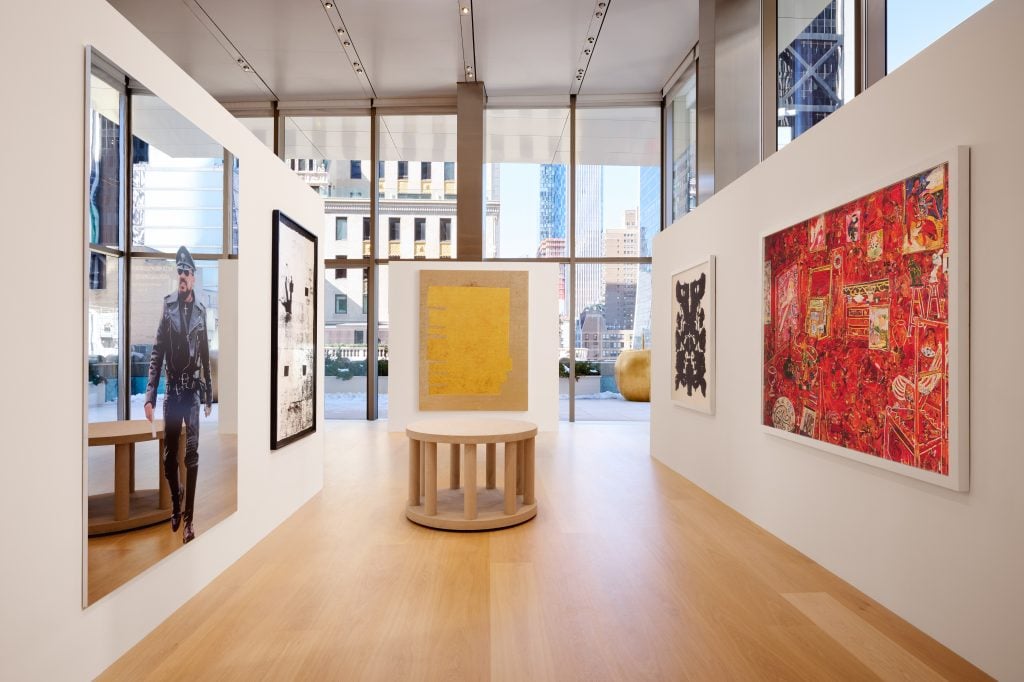
An installation view of “Culture of Creativity.” Photo: Jason Schmidt. Courtesy Tiffany & Co.
Upon entering, it’s hard not to be gobsmacked. It looks like an art storage warehouse that happens to have cubicles. There is a full staff on-duty, but it is eerily silent like a library. We pass what are called “war rooms”: each luxury brand Marino collaborates with gets their own space and the walls are surrounded with art (his staff requested that details about these works not be published).
“I’ll take some artist and I sort of go, ‘their innermost expression really suits Chanel,’” he explained. “’This artist indicates the spirit of Dior.’ For Tiffany I did artists that I thought would be good for a jewelry store. Sarah Sze, it’s all about exploding diamonds. I liked Rashid Johnson’s cracked mirror because he always said it was like a diamond.” Marino is being glib, but It’s hard to quantify how much his predilections have shaped modern life, how one man’s taste (and one man’s taste in art) can subversively permeate the world around us.
Outside of Marino’s own office space is a bowl of special order all black M&M’s. Leaning against the wall next to an ancient Greek vase are framed Wolfgang Tillmans photos: one is of multi-colored eggs and another is of a reclining bare male torso in Adidas gym shorts. There is a gorgeous green plexiglass sculptural piece from Tillmans’s 2023 David Zwirner show “Fold Me.” Nearby is Franz von Stuck’s 1898 oil on wood depicting two satyrs head-butting each other, Kämpfende Faune.
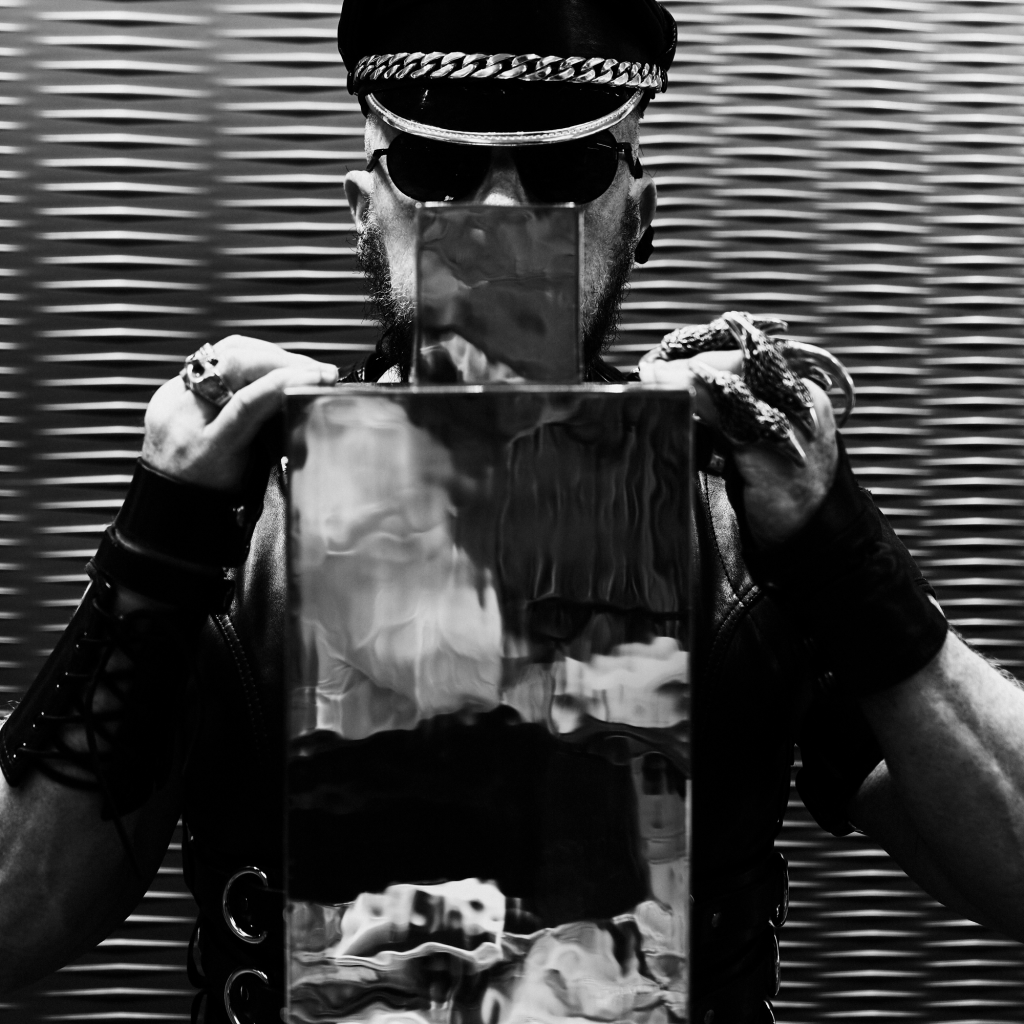
Peter Marino with Peter Marino by Not Vital. Photo: Manolo Yllera.
“He’s very complex,” Marino said of Tillmans. “He’s an artist of combinations. One photo can never define Wolfgang Tillmans. That’s why the MoMA show was so monumental. It’s their relationship to each other, the way he puts them on the wall, the way the whole room feels. I relate to that. It’s really the combination, everything that makes the whole.”
Throughout the space is also a stockpile of Tiffany silver and metalwork that Marino has been amassing for 40 years. Robert Mappelthorpe’s former lover and benefactor Sam Wagstaff started him on this particular collecting journey back in the 1980s, and Marino inherited some of his pieces. Some objects from his wider collection are included the Landmark exhibit.
“I believe in karma and things that you touch,” Marino said. “When I heard Bernard Arnault bought Tiffany, I was thrilled. I said, “I got Tiffany karma, I’ve been collecting Tiffany Silver for 40 years.’ He was laughing, and said, ‘You have not.’ I said, ‘I have, now gimme the job!’ I’ve always loved it. I think it’s the greatest American luxury company that ever existed.”
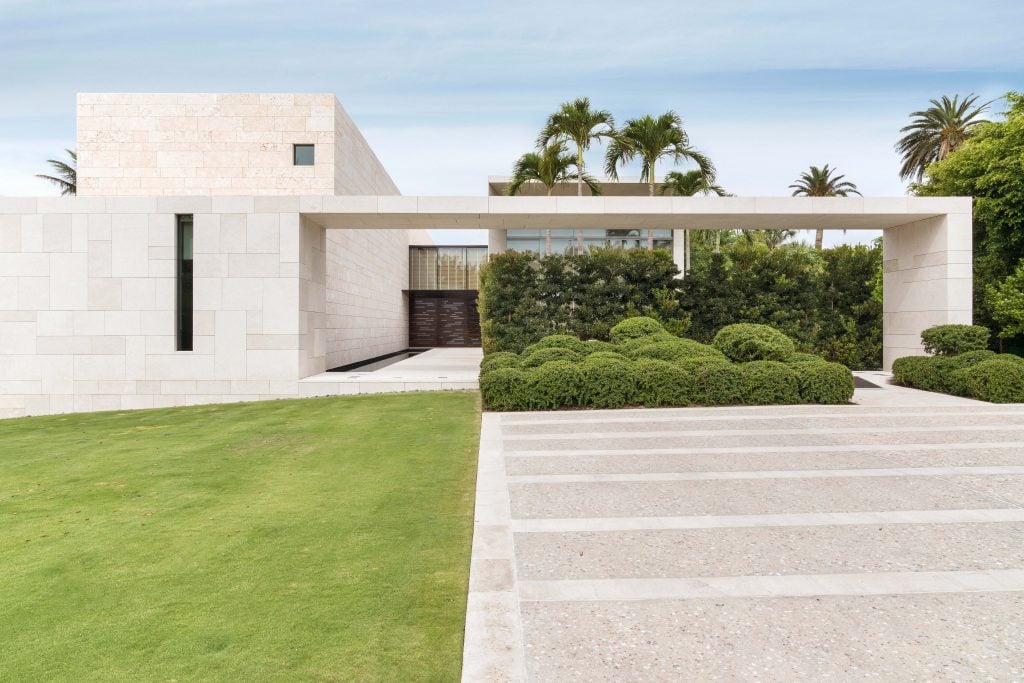
A Marino-designed residence from Ten Modern Houses by Peter Marino. Photo: Manolo Yllera, courtesy of Phaidon.
On the table next to various maquettes for existing and planned buildings is a sample of his next book, Ten Modern Houses. It will be released in June with Phaidon. “Most of the private clients don’t want or need the publicity,” he said. “As an architect, half the work you do is never seen by anybody. This is inside and outside, the complete package, which you don’t find with most architects—they do terrible interiors.”
Marino’s oeuvre is so broad but he sees a through line in his disparate work that transcends many different styles. “Don’t pianists play Mozart and Wagner and Rachmaninoff? They expect architects to only have one look,” he said. “That’s like a pianist going, ‘Well, I play Chopin and that’s it.’”
He’s well-aware his skill sets are a gift. “The only thing God gave me was a killer pair of eyes. I’ve got to be honest. I’ve got no sense of taste or smell. But I’ve really got a sense of visual things and visual things to me are like food. I like to give people food all the time, like giving the cows some hay,” he said. “I think you can get full on visual things, too.”





